Objectives
- Consider how language shapes our thinking.
- Review some of the language used to describe disability.
- Analyze how language is used and consider implications.
Estimated Time
- Introduction – 5 minutes
- Analysis of language as a group – 10 minutes
- Instructions for activity and set up – 5 minutes
- Debrief of activity – 5 to 15 minutes
- Closing – 5 minutes
Materials Needed
- Computer and LCD Projector
- Activity cards: Language of Disability Activity Cards (PDF)
- Slides: Language of Disability PowerPoint Slides (PPT)
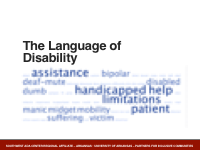 [Bring up title slide]
[Bring up title slide]
![]() Our topic today is “The Language of Disability.” Many people often dismiss the topic of language and word choice as being about “political correctness.” Research is making it more and more clear that our language shapes our thought.
Our topic today is “The Language of Disability.” Many people often dismiss the topic of language and word choice as being about “political correctness.” Research is making it more and more clear that our language shapes our thought.
The words we choose also have an impact on those around us.
 [Advance to slide 2]
[Advance to slide 2]
![]() The American Heritage Book of English Usage, published in 1996 states: “One of the most basic ways of showing respect for others is to refer to them by the names with which they have chosen to identify themselves and to avoid using names that they consider offensive.”
The American Heritage Book of English Usage, published in 1996 states: “One of the most basic ways of showing respect for others is to refer to them by the names with which they have chosen to identify themselves and to avoid using names that they consider offensive.”
Rather than setting out certain rules about what is okay and is not okay to say, I’d like for us to have a dialogue about language and disability.
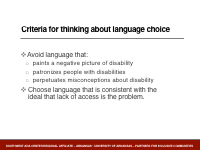 [Advance to slide 3]
[Advance to slide 3]
![]()
When we choose our language related to disability, I would suggest that we want to consider the following:
- Avoid language that:
- paints a negative picture of disability
- patronizes people with disabilities
- perpetuates misconceptions
- Choose language that is consistent with the ideal that lack of access is the problem.
![]() [Spend time discussing each bullet point if needed, asking “What does that mean to you? Can you think of an example?”]
[Spend time discussing each bullet point if needed, asking “What does that mean to you? Can you think of an example?”]
Let’s look at a few common phrases and think about how they measure up to these criteria.
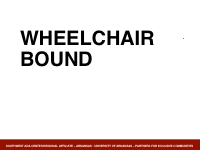 [Advance to slide 4]
[Advance to slide 4]
![]()
Let’s start with the phrase “wheelchair bound.”
![]() [Pose these questions for discussion.]
[Pose these questions for discussion.]
- What do you think about this phrase?
- Does this phrase paint a negative image of disability?
- Does this phrase emphasize that access is the problem (rather than the bodily condition)?
- Does this phrase patronize disabled people?
- Does this phrase promote misconceptions?
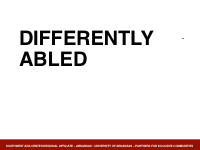 [Advance to slide 5]
[Advance to slide 5]
Okay, what about this phrase: Differently Abled
![]() [Pose these questions for discussion.]
[Pose these questions for discussion.]
- Does this phrase paint a negative image of disability?
- Does this phrase emphasize that access is the problem (rather than the bodily condition)?
- Does this phrase patronize disabled people?
- Does this phrase promote misconceptions?
“Differently Abled” would be considered a euphemism for disability. Many people use euphemisms because they think they are more positive than the word “disability.” But let’s look at the definition of euphemism.
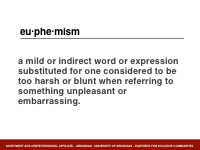 [Advance to slide 6]
[Advance to slide 6]
![]() The definition of euphemism is:
The definition of euphemism is:
“A mild or indirect word or expression substituted for one considered to be too harsh or blunt when referring to something unpleasant or embarrassing.”
![]() So what message does using a euphemism for disability send?
So what message does using a euphemism for disability send?
 [Advance to slide 7]
[Advance to slide 7]
What about the phrase “mentally challenged”?
![]() [Pose these questions for discussion.]
[Pose these questions for discussion.]
- Is it also a euphemism?
- Does this phrase paint a negative image of disability?
- Does this phrase emphasize that access is the problem (rather than the bodily condition)?
- Does this phrase patronize disabled people?
- Does this phrase promote misconceptions?
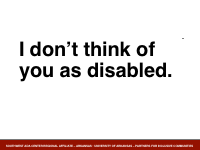 [Advance to slide 8]
[Advance to slide 8]
You might hear someone say “I don’t think of you as disabled.”
![]() [Pose these questions for discussion.]
[Pose these questions for discussion.]
- What message does that send about being disabled?
- Does this phrase paint a negative image of disability?
- Does this phrase patronize disabled people?
- Would we say this about other identities? That is, “I don’t think of you as gay” or “I don’t think of you as Black.”
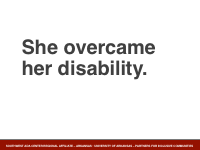 [Advance to slide 9]
[Advance to slide 9]
What about this: “She overcame her disability.”
![]() [Pose these questions for discussion.]
[Pose these questions for discussion.]
- What message does that send about disability?
- Where does it locate the problem?
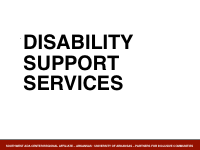 [Advance to slide 10]
[Advance to slide 10]
![]() Let’s do one more together.
Let’s do one more together.
What if the office on campus is named “Disability Support Services”?
![]() [Pose these questions for discussion.]
[Pose these questions for discussion.]
- Does this phrase paint a negative image of disability?
- Does this phrase emphasize that access is the problem (rather than the bodily condition)?
- Does this phrase patronize disabled people?
- Does this phrase promote misconceptions?
![]() Next, I’d like for you to try this in pairs on your own. You’ll each get a card. Find someone with a card that is the same color as yours and discuss the two words or phrases on your cards. Look at the criteria we discussed (I’ll leave that slide up for you.) and see which one is more consistent with the criteria. Be prepared to share highlights of your discussion with the rest of us. You’ll have 5 minutes to discuss and to take some notes on your discussion.
Next, I’d like for you to try this in pairs on your own. You’ll each get a card. Find someone with a card that is the same color as yours and discuss the two words or phrases on your cards. Look at the criteria we discussed (I’ll leave that slide up for you.) and see which one is more consistent with the criteria. Be prepared to share highlights of your discussion with the rest of us. You’ll have 5 minutes to discuss and to take some notes on your discussion.
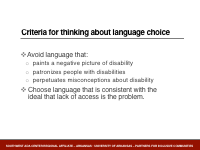 [Advance to slide 11]
[Advance to slide 11]
[Activity preparation instructions: Download the printable version of the activity cards. The HTML table below gives you an accessible version of the cards that identifies each card and it’s color, giving you a key to refer to. The printed version of the cards provide good color contrast and are in 18 point font with the color of the card labeled. Make sure to Braille your set of cards to provide full access.]
[To debrief the activity, choose the option that best suits your time-frame and the number of participants you have. You can have each group report out. Select 2 or 3 to report out. Or ask questions like, what did you discover from your discussion and get volunteers to respond.] He says, “What you call someone is how you treat them.” Feel free to contact me if you’d like more resources on this topic. I’d like to thank the Southwest ADA Center Regional Affiliate of Arkansas, a program of the University of Arkansas Partners for Inclusive Communities for developing the content provided in this presentation.![]() [To conclude following the debrief]
Thank you for joining me in thinking about the language of disability today. I’d like to end with one more thought. This is a quote from Nick Marcellino, the brother of Rosa Marcellino for whom the law “Rosa’s law” was named. This is the law that removes the language ‘mental retardation’ from federal law, replacing it with ‘intellectual disability.’
[To conclude following the debrief]
Thank you for joining me in thinking about the language of disability today. I’d like to end with one more thought. This is a quote from Nick Marcellino, the brother of Rosa Marcellino for whom the law “Rosa’s law” was named. This is the law that removes the language ‘mental retardation’ from federal law, replacing it with ‘intellectual disability.’ 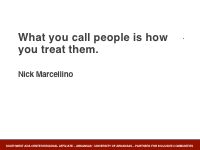 Advance to slide 12
Advance to slide 12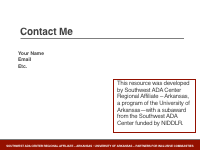 Advance to slide 13
Advance to slide 13
Activity Cards
| More Problematic | Less Problematic |
|---|---|
| Confined to a wheelchair (Light Blue) |
Uses a wheelchair (Light Blue) |
| He suffers from cerebral palsy (Light Pink) |
He has cerebral palsy (Light Pink) |
| She is 21 but functions as a 6 year old. (Light Purple) |
She is 21. She has an intellectual disability. (Light Purple) |
| What limitations do you have? (Light Teal) |
What kinds of barriers do you encounter? (Light Teal) |
| He has special needs. (White) |
He needs equal access. (White) |
| What accommodations do you require? (Light Orange) |
What accommodations will remove the barriers? (Light Orange) |
| He’s a stroke victim. (Light Gray) |
He had a stroke. (Light Gray) |
| She’s a deaf-mute. (Light Yellow) |
She is Deaf. (Light Yellow) |
| Park in the handicapped space. (Light Green) |
You can park in the accessible parking. (Light Green) |
| She is able-bodied. (Light Brown) |
She is non-disabled. (Light Brown) |

